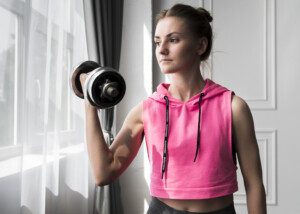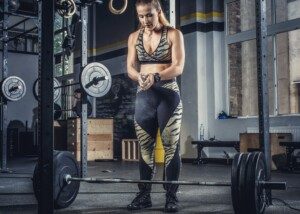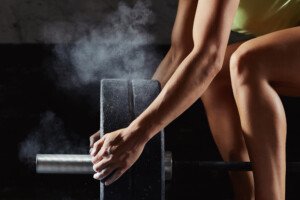
Some reasons will surprise you why some women are just naturally very strong.
What makes a woman naturally strong? Is it size? Not always.
If the size is mostly excess fat and/or long bones (tallness), this won’t make a woman strong.
A few of the factors that make a woman naturally strong are variables that you cannot see simply by looking at her.
What makes some women naturally strong?
• Tendons that insert far from the joint that the tendon pulls on (or, to put it another way, the insertion point to the axis of rotation).
• High percentage of fast twitch muscle fiber to slow twitch muscle fiber.
These two factors cannot be readily seen when you look at an average woman, but if her muscles are developed from training, you could see if she has long or short tendon insertion points.
“Long” insertion points provide a mechanical advantage to lifting, and you’re born with the length of your insertion points; they can’t be changed with training.
Tendon Power
Here’s an analogy to help you understand how this influences strength. Suppose you’re pulling at the knob of a very stubborn door.
The door just won’t open (let’s say it’s an old house and the frame has shrunk or whatever, and the door is “stuck” in the frame). You pull and pull on that knob but the door won’t budge.
Now let’s suppose you fasten a gizmo around the knob that has a one-foot-long rod or extension made of metal or wood, and at the end of the extension is a handle.
You pull at the handle, and voila, the door opens! Imagine how much even easier this would be if the rod were 10 feet long. Man, just a tiny tug and that door would open.
Though this is a significantly scaled-up analogy, you should now understand how a longer tendon insertion creates more strength.
The door symbolizes bone. The rod or extension symbolizes a long tendon.
The gizmo around the doorknob symbolizes the insertion point. Your hand pulling on the handle symbolizes muscle.
Muscle pulls bone. When you lift weights or move a joint, muscles pull the bone.
Bend your elbow so that your arm forms a 90 degree angle: Your biceps muscle group is pulling against the bones in your forearm.
A longer tendon that connects the biceps to your forearm bones is like that one-foot rod connecting your hand to the doorknob.
Fast Twitch Power
Fast twitch muscle fiber is designed for brief, explosive movements, and these are required for displays of strength.
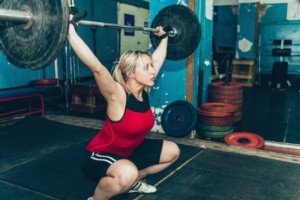
Shutterstock/Microgen
Slow twitch fiber is designed for endurance activities. This is why the bodies of Olympic marathon runners are skinny and waif-like, while the physiques of sprinters are impressively muscled.
Like elite sprinters, champion powerlifters and Olympic-style weightlifters have a high percentage of fast twitch muscle fiber to slow twitch.
But not all weightlifters can be great sprinters, and not all sprinters can be great weightlifters.
Other Factors that Make a Woman Naturally Strong
A champion powerlifter, blessed with a ton of fast twitch muscle fiber, may bomb at sprinting due to the wrong anthropometrics.
Let’s say we have a champion sprinter and a champion powerlifter, both 5’5” and 130 pounds, stand side by side.
You can bet they’ll have different anthropometrics: limb proportions.
• The sprinter’s torso will be shorter than the powerlifter’s torso (i.e., the sprinter will be “higher waisted”).
• The powerlifter’s knees will be higher than the sprinter’s knees (the powerlifter will have shorter femurs or thigh bones).
• The powerlifter’s arms may be longer than the sprinter’s arms (a sprinter can benefit from long arms, but a champion powerlifter of the same height whose best lift is the deadlift may have even longer arms).
So if you have 90 percent fast twitch fiber and 10 percent slow twitch, you’re designed for brief bursts of power, but if your torso is shorter than your femurs, and your arm span is two inches shorter than your overall height, you can forget powerlifting.
Arms several inches longer than overall height means a woman won’t have to bend over as far to pick a heavy object off the floor.
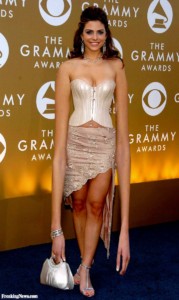
However, she’ll be at a disadvantage thrusting that heavy object up and over her head, with those long arms having to travel through a greater range of motion.
It would be extremely easy for the woman pictured above to lift 100 pounds a few inches off the floor if her arms were really that long, but she’d have one heck of a time lifting a bowling ball over her head and straightening her arms (weak!)
That’s why in Olympic-style lifting, where heavy weight must be quickly thrust overhead, the athlete’s arms are notably short—relative to body height.
With a smaller range of motion, courtesy of short arms, it’s easier for the athlete to move a heavy barbell from the floor to overhead.
Overall height is not the issue; it’s whether or not arm span is shorter or longer than the overall height.
Long arms relative to height create more torque, which means such a woman has great potential in sports requiring throwing such as discus, hammer throw, javelin and softball pitching.
But relatively short arms (forget discus or pitching) are also a big advantage in the bench press and any pressing motion such as dumbbell incline press, overhead press, and also the pull-up.
What else makes a woman naturally strong?
Naturally higher levels of testosterone will help; this will go towards muscle development from training.
There are many other factors that make a woman strong, but they are acquired, such as the rage that surges through a woman’s body as she’s lifting a car off her pinned child.
But let’s get one thing straight: Size does not make a woman naturally strong.
A “skinny” woman with long tendon insertions and lots of fast twitch muscle fiber will likely do better at hoisting heavy crates into a truck than will the 200 pound (excess fat) taller woman who has short tendon insertions and mostly slow twitch muscle fiber!
 Lorra Garrick is a former personal trainer certified through the American Council on Exercise. At Bally Total Fitness she trained women and men of all ages for fat loss, muscle building, fitness and improved health.
Lorra Garrick is a former personal trainer certified through the American Council on Exercise. At Bally Total Fitness she trained women and men of all ages for fat loss, muscle building, fitness and improved health.
.


